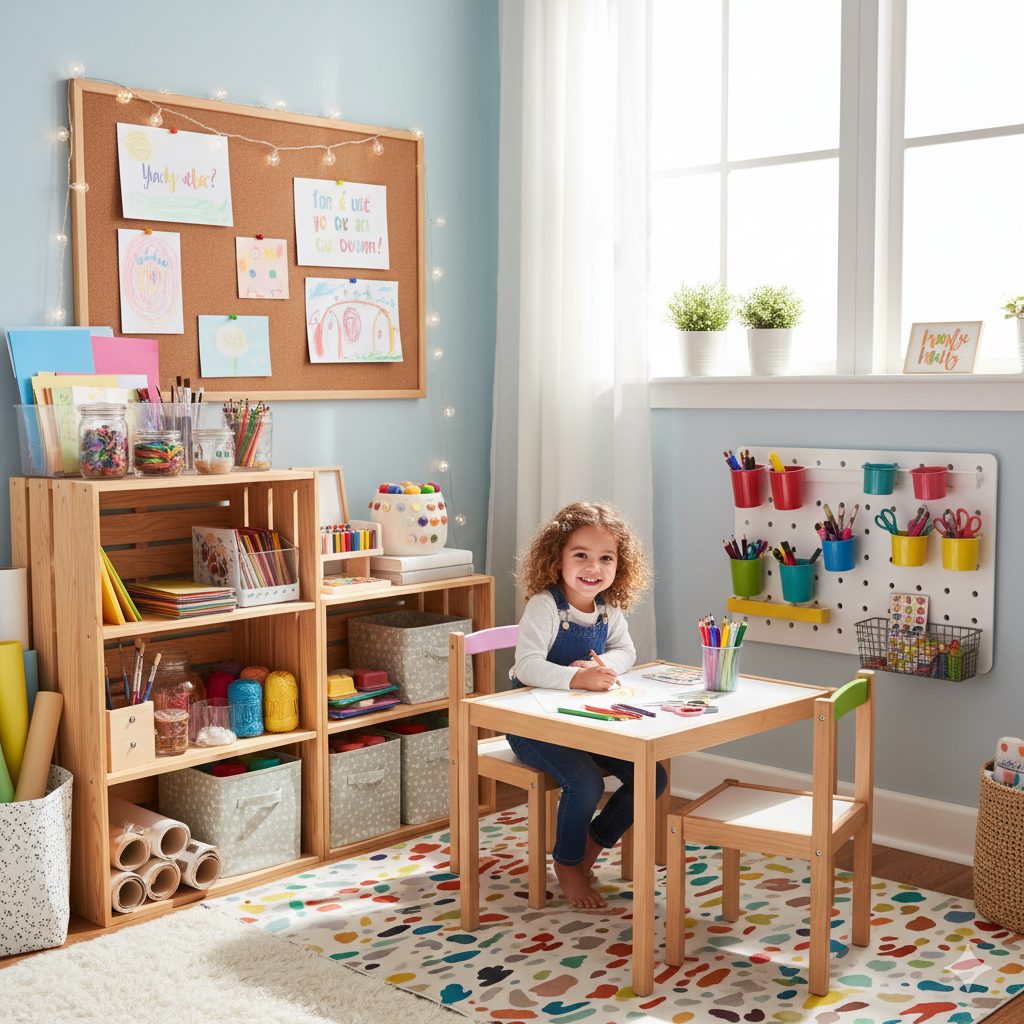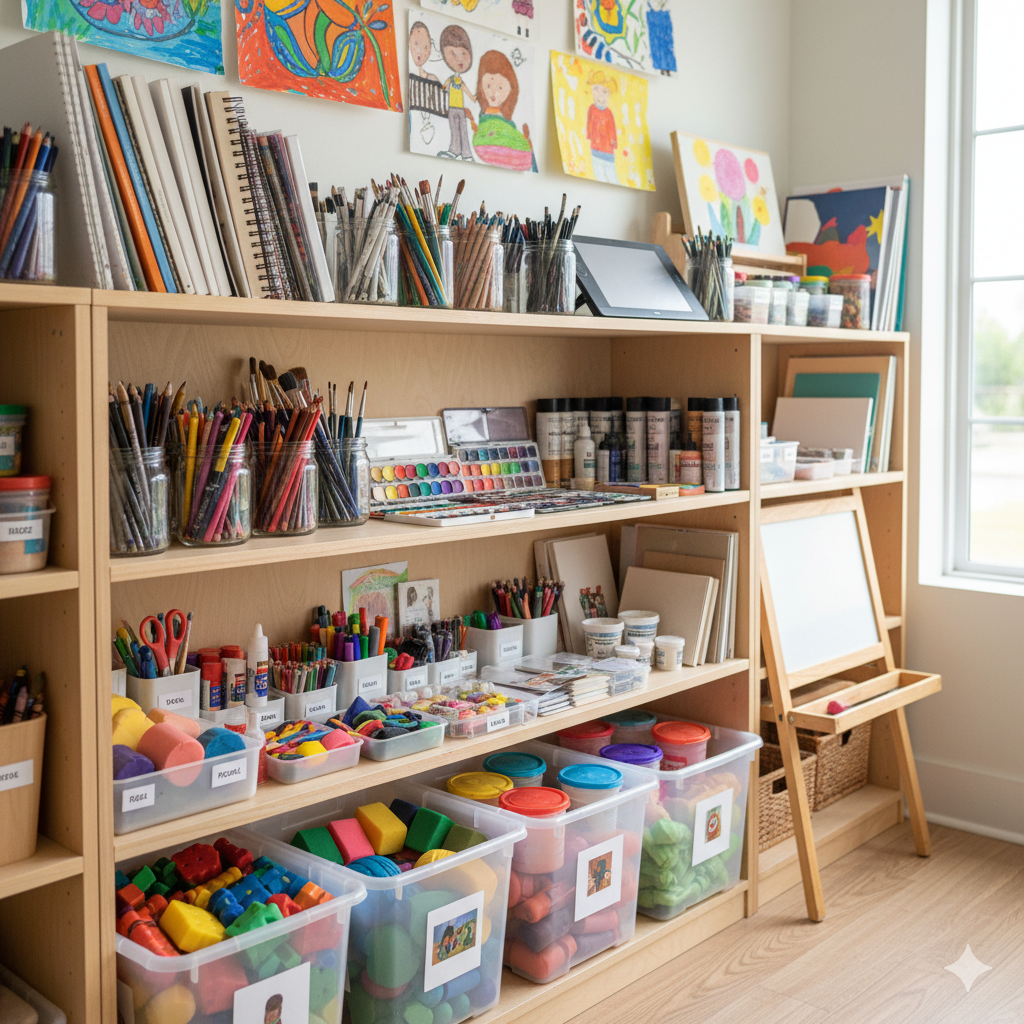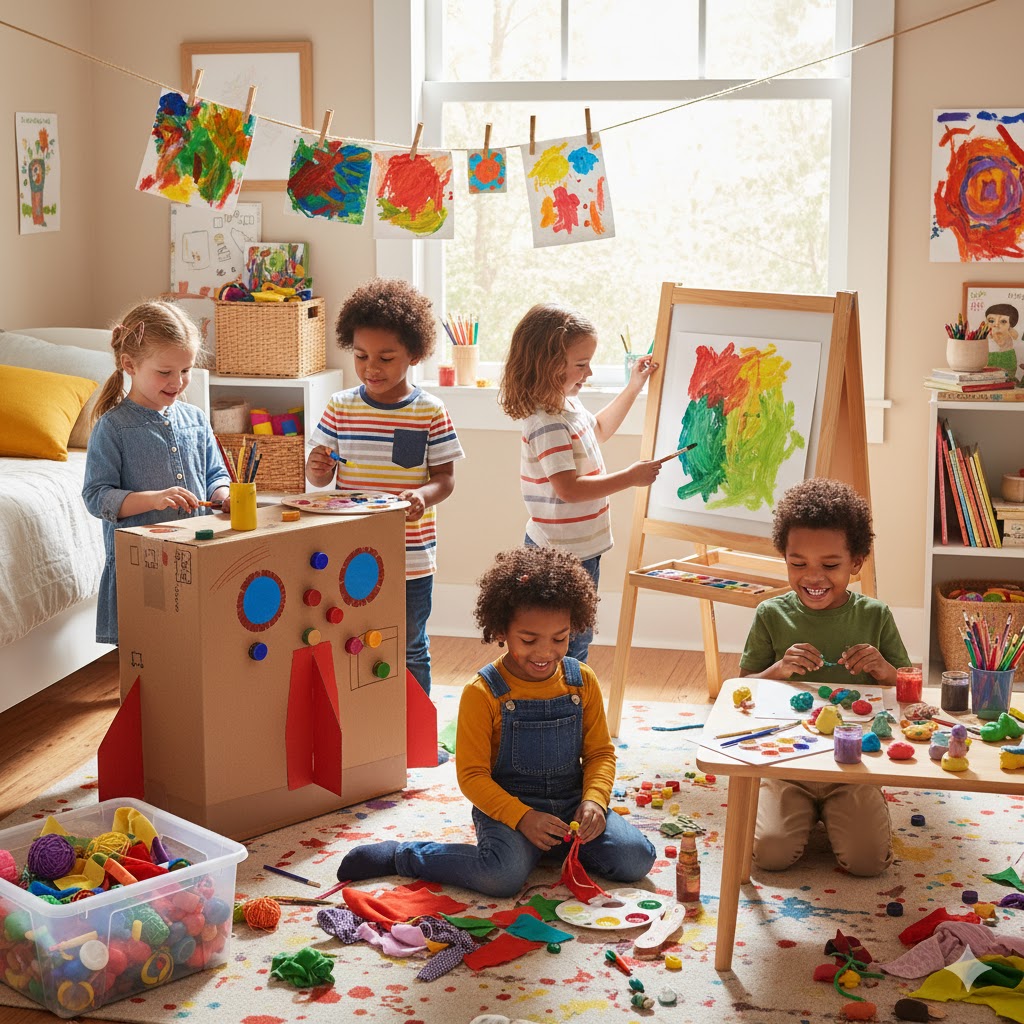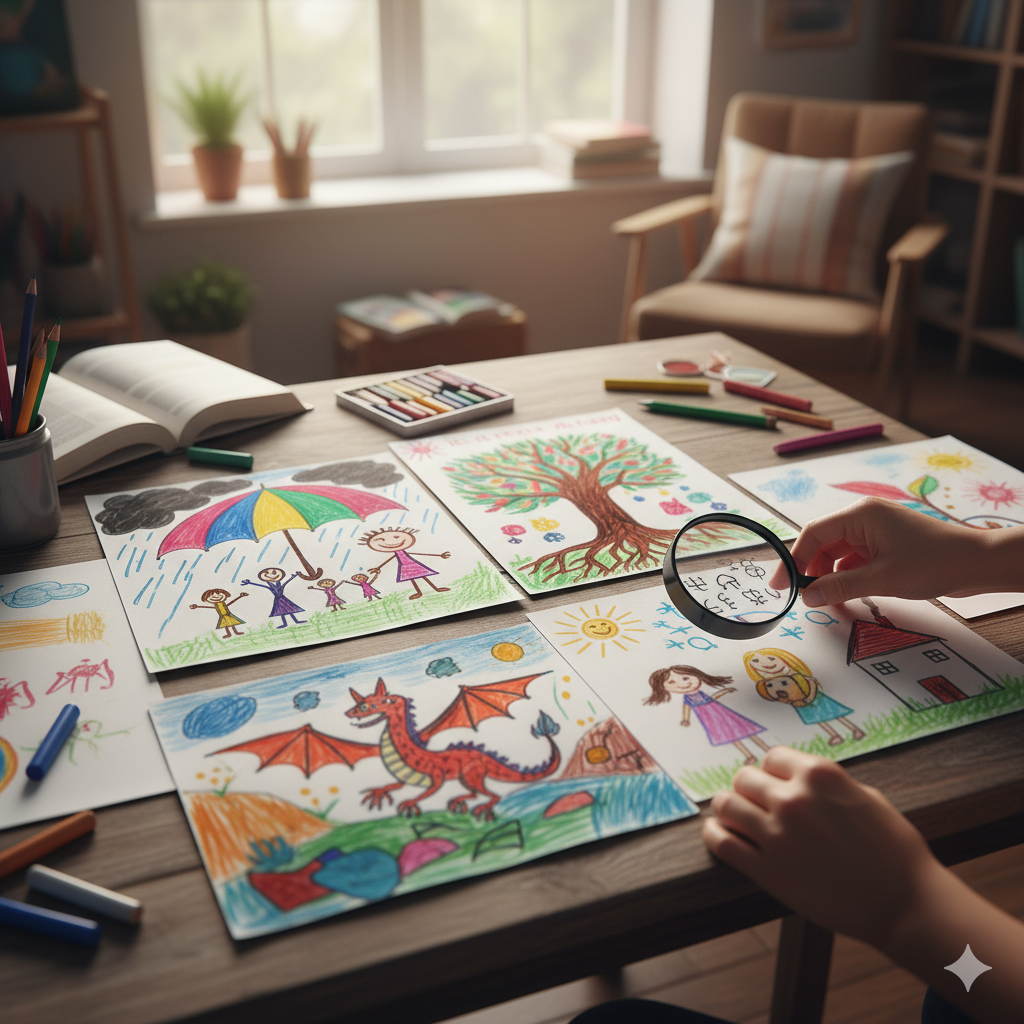Creating an Inspiring Art Space at Home for Kids
I'll never forget the transformation that happened when we converted our tiny breakfast nook into an art space for my daughter. What was once a cluttered corner became her creative sanctuary, and suddenly, art wasn't just something she did occasionally—it became part of her daily rhythm. She started reaching for crayons instead of asking for screen time, and I found myself marveling at how a simple change of space could unlock such creative potential.
Every child deserves a dedicated space where they can explore their creativity freely. Whether you have an entire room to dedicate or just a small corner, creating an inspiring art space at home can have a profound impact on your child's creative development. The magic isn't in having the perfect setup—it's in sending the message that creativity matters in your family.
Why a Dedicated Art Space Matters
The Message It Sends
When I first set up our art space, I didn't realize how much it would communicate to my daughter. Having a dedicated creative area sends powerful messages: that artistic expression is valued in our home, that she has the independence to access materials without asking permission, and that there's a special place where she can focus on creating without interruption.
I've watched her confidence grow as she takes ownership of her creative space. She knows where everything belongs, she can reach her favorite supplies, and she has the freedom to create whenever inspiration strikes. It's amazing how having control over their creative environment can build such confidence in children.
More Than Just Art Supplies
A dedicated art space does so much more than provide a place to store crayons and paper. It becomes a hub for fine motor skill development as children manipulate different tools and materials. It supports cognitive development by helping them plan projects and organize their thoughts. Most importantly, it provides emotional security—a safe place where they can express themselves freely and process their feelings through creativity.
I've noticed that when my daughter has had a difficult day at school, she naturally gravitates toward her art space. It's become her way of decompressing, working through emotions, and finding her center again. That's the real power of a dedicated creative space—it becomes a sanctuary for both creativity and emotional well-being.
Planning Your Art Space
Assessing Your Available Space
Full Room Options:
If you have the space, consider dedicating an entire room to creativity. A spare bedroom or office can be transformed into a dedicated art studio, while basement or attic spaces often provide the room and flexibility needed for messy projects. Large walk-in closets can work surprisingly well, and converted garages or sheds offer excellent space for larger creative endeavors.
Corner Solutions:
Most families find success with corner solutions that work within existing spaces. A living room corner can become a cozy creative nook, while a kitchen nook provides easy access to water for cleanup. Bedroom corners offer privacy and personal space, and hallway alcoves can be surprisingly effective for smaller setups.
Mobile Solutions:
For families with limited space, mobile solutions offer flexibility. Rolling art carts can move between rooms as needed, portable art stations can be set up anywhere, art caddies or totes provide easy transport of supplies, and wall-mounted fold-down tables can be tucked away when not in use.
Key Considerations
Location Factors:
When choosing your location, prioritize natural light by placing the space near windows when possible, easy cleanup by positioning it near a water source or easy-to-clean surfaces, low traffic areas away from high-traffic zones, temperature control for year-round comfort, and noise level considerations that match both household activity and your child's preferences.
Safety Requirements:
Safety should always be the top priority. Ensure all art supplies are non-toxic and safe for children, provide adequate ventilation for paints, markers, and other materials that might release fumes, keep hazardous items securely stored out of reach, choose surfaces that can be easily cleaned, and child-proof the area by securing furniture and covering electrical outlets.
Essential Furniture and Equipment
Work Surfaces
Tables and Desks:
Choose tables and desks that are child-sized with appropriate height for comfortable working, consider adjustable height options that grow with your child, ensure large surface area for multiple projects, select easy-to-clean surfaces like laminate, tile, or sealed wood, and invest in sturdy construction that can handle enthusiastic use.
Alternative Work Surfaces:
Don't limit yourself to traditional tables. Floor mats work well for large projects or sensory play, easels provide standing work surfaces for large paintings, clipboards offer portable drawing options anywhere in the house, and drawing boards with angled surfaces can make drawing more comfortable for extended periods.
Storage Solutions
Open Shelving:
Open shelving provides visibility so children can see what's available, accessibility for easy reaching and putting away, clear organization with categories for different materials, and flexibility to rearrange as needs change.
Closed Storage:
Closed storage options include cabinets for messy or expensive supplies, drawers for smaller items and tools, bins and baskets for loose materials and collections, and hanging organizers for brushes, tools, and small items.
Creative Storage Ideas:
Think creatively about storage solutions. Mason jars work perfectly for brushes, pencils, and small tools, muffin tins are great for sorting small items like beads or buttons, shoe organizers can be hung on walls for supplies, and old dressers or entertainment centers can be repurposed as art storage.
Organizing Art Supplies
Basic Supply Categories
Drawing Materials:
Essential drawing materials include pencils in both regular and colored varieties, crayons in various sizes and types, markers in both washable and permanent options, chalk and pastels for different textures, and charcoal and graphite for more advanced drawing techniques.
Painting Supplies:
Painting supplies should include watercolors and appropriate brushes, tempera paints for bold colors, finger paints for sensory exploration, paint palettes and mixing trays for color experimentation, and water containers and rags for cleanup.
Craft Materials:
Craft materials include child-safe scissors for cutting, glue and tape for assembly, construction paper in various colors, fabric scraps for texture and collage, and natural materials like leaves, sticks, and shells for organic elements.
Modeling Materials:
Modeling materials include play dough and clay for three-dimensional creation, modeling tools for shaping and texturing, rolling pins and cutters for forming shapes, drying racks for finished pieces, and storage containers to keep materials fresh.
Organization Strategies
By Age Group:
Organize materials by age group with toddlers (2-3) having large, safe materials within easy reach, preschoolers (3-5) using a mix of basic and advanced materials, and school-age children (6+) having access to the full range of materials with proper storage.
By Material Type:
Group materials by type with drawing tools organized together in easy-access containers, painting supplies organized by type and color, craft materials sorted by category and size, and paper and canvases stored flat to prevent damage.
By Frequency of Use:
Arrange materials by frequency with daily use items in the most accessible locations, weekly use items in secondary storage areas, and special occasion materials in higher or locked storage.
Creating an Inspiring Atmosphere
Color and Design
Wall Colors:
Choose wall colors that support creativity with light, neutral backgrounds that let the art be the focus, accent colors in bright, inspiring shades for motivation, classic white or light gray for a clean, versatile look, or soft pastels that create a calming and creative atmosphere.
Decorative Elements:
Add decorative elements that inspire creativity including inspiration boards to display art, quotes, and ideas, artwork display areas where you can rotate children's creations regularly, nature elements like plants, natural light, or nature-inspired decor, and personal touches that reflect the child's interests and personality.
Lighting Considerations
Natural Light:
Consider natural light sources with north-facing windows providing consistent, diffused light, south-facing windows offering bright light but with potential glare issues, east-facing windows giving morning light that's good for early risers, and west-facing windows providing afternoon light perfect for after-school activities.
Artificial Lighting:
Supplement with artificial lighting including overhead lighting for bright, even illumination of the entire space, task lighting for focused light during detailed work, adjustable lighting with dimmer switches for different activities, and color-corrected bulbs that provide full-spectrum lighting for accurate color perception.
Inspirational Elements
Display Areas:
Create display areas using bulletin boards for displaying artwork and inspiration, string and clips for hanging drawings and paintings, shelves for displaying 3D art and sculptures, and magnetic surfaces for easy display changes.
Motivational Decor:
Add motivational decor elements including art quotes with inspiring words about creativity, famous artwork through age-appropriate reproductions, nature posters featuring botanical or wildlife illustrations, and art technique posters providing step-by-step guides for different techniques.
Making It Child-Friendly
Accessibility and Independence
Height Considerations:
Consider height accessibility with all materials within the child's reach, step stools for safely accessing higher shelves, adjustable furniture that grows with the child, and multiple work heights offering both standing and sitting options.
Ease of Use:
Design for ease of use with simple organization using clear, logical categories, easy cleanup through materials that are simple to put away, clear labels with pictures and words for easy identification, and consistent placement where items are always in the same location.
Safety Features
Child-Safe Materials:
Ensure child safety with non-toxic supplies that are safe for children, age-appropriate tools like scissors, brushes, and tools suited for their age, washable materials for easy cleanup for parents, and durable construction that can handle enthusiastic use.
Safety Measures:
Implement safety measures including securing all furniture to walls, covering electrical outlets for safety, storing sharp tools like scissors and knives in locked or high storage, and ensuring adequate ventilation for paints and solvents.
Maintaining and Updating the Space
Regular Maintenance
Daily Tasks:
Daily maintenance includes quick cleanup by putting away materials after use, surface cleaning by wiping down tables and easels, supply check to ensure materials are in good condition, and display rotation to update artwork displays regularly.
Weekly Tasks:
Weekly maintenance involves deep cleaning with thorough cleaning of all surfaces, supply inventory to check what needs to be restocked, organization review to ensure everything is in its place, and safety check to look for any safety concerns.
Monthly Tasks:
Monthly maintenance includes supply refresh by replacing worn or used-up materials, space evaluation to assess if the setup is still working, seasonal updates to change displays and decorations, and growth adjustments to modify setup as the child grows.
Adapting as Children Grow
Toddler to Preschool:
As toddlers grow into preschoolers, add complexity by introducing more advanced materials, increase independence by allowing more self-directed activities, expand storage by adding more categories and materials, and enhance safety by updating safety measures as they grow.
Preschool to School Age:
Transitioning from preschool to school age involves introducing advanced materials and professional-quality supplies, adding materials for specific techniques to support skill development, providing project storage space for longer-term projects, and creating collaboration space for working with friends.
School Age to Teen:
Moving from school age to teen years means upgrading to professional materials and high-quality art supplies, adding specialized tools and equipment for specific art forms, respecting their growing independence with more private space, and integrating digital space for digital art tools.
Budget-Friendly Solutions
Repurposing and Upcycling
Furniture Ideas:
Get creative with furniture by repurposing an old dining table by cutting down legs for child height, converting a kitchen island into an art station, turning a bookshelf on its side for art supply storage, or converting dresser drawers into art supply storage.
Storage Solutions:
Use everyday items for storage including mason jars for organizing small supplies, shoe boxes for categorizing materials, egg cartons for sorting small items, and plastic containers from food storage repurposed for art supplies.
DIY Projects:
Create DIY solutions like making a pallet easel from wooden pallets, using magnetic paint to create magnetic surfaces for display, adding chalkboard paint to create drawing surfaces on walls, or installing pegboard to create a customizable storage wall.
Smart Shopping Tips
Where to Buy:
Smart shopping locations include thrift stores for finding unique furniture and storage, garage sales for discovering hidden treasures, online marketplaces for finding deals on used furniture, and art supply stores where you can wait for sales on quality materials.
What to Invest In:
Focus your investment on quality brushes since better tools create better results, good paper because quality paper makes a difference, durable furniture that will last through years of use, and storage solutions since good organization saves money long-term.
Conclusion
Creating an inspiring art space at home is one of the best investments you can make in your child's creative development. Whether you have a dedicated room or just a corner, the key is to make the space functional, inspiring, and truly theirs.
Remember that the best art space is one that your child actually uses. Pay attention to what works and what doesn't, and be willing to adapt and change as your child grows and their interests evolve. The goal is to create a space that encourages creativity, independence, and joy in artistic expression.
Start with the basics and build from there. Even a simple setup with basic materials in an organized way can inspire hours of creative exploration. As your child grows and their interests develop, you can expand and enhance the space to meet their evolving needs.
The most important thing is to create an environment where your child feels free to explore, experiment, and express themselves creatively. When you provide the right space and materials, you're giving your child the tools they need to develop their artistic voice and creative confidence.
Want to see how your child's creative development is progressing? Our AI-powered analysis tool can provide insights into the artistic techniques, creative expression, and developmental patterns in your child's drawings. Try our child drawing analysis tool to discover what your child's artwork reveals about their creative growth.
---
Remember: The best art space is one that evolves with your child. Start simple, observe what works, and be willing to adapt and change as your child's needs and interests develop.



